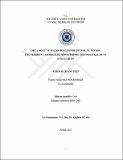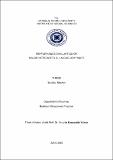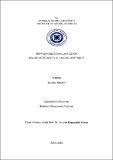DSpace Repository
ORTA DOĞU VE HAZAR BÖLGESİNDE PETROL VE PETROL ÜRÜNLERİNİN TAŞIMACILIĞI YÖNETİMİNDE YENİ POLİTKALAR VE STRATEJİLER
JavaScript is disabled for your browser. Some features of this site may not work without it.
| dc.contributor.author | Naghili Hokmabadi, Rasoul
|
|
| dc.date.accessioned | 2019-05-28T13:30:07Z | |
| dc.date.available | 2019-05-28T13:30:07Z | |
| dc.date.issued | 2017 | |
| dc.identifier.uri | http://hdl.handle.net/11547/2289 | |
| dc.description.abstract | Araştırmanın asıl konusuna girilmeden önce petrolün tarihsel boyutu, petrol piyasasının genel rakipleri, yeni üreticiler, tüketiciler ve dağıtım kollarının tanıtımı yapılmıştır ve ardından dünyadaki petrol rezervlerinin üretimi, tüketimi ve bunlarla ilgili üretim ve dağıtım maliyetleri üzerinde detaylı bilgi verilmiştir. Petrol fiyatlandırılmasında hangi kurumların karar verdiği ve dünya ekonomisi üzerindeki etkileri tartışılır. Orta Doğu ve Basra Körfezi’nin önemi Hazar bölgesi petrolü üzerinde ve transit konusunda yazılır. Bu tezin temel konusu olduğu için Hazar kıyı ülkeleri, Ortadoğu ve Irak petrolü geniş halde incelenir. Sovyetler Birliği’nin dağılmasından sonra yaşanan siyasi değişim sonucunda petrol ve doğal gaz ile zengin Türk ülkelerinin başkaldırması ile enerji sektöründe yeni ufuklar açıldı ve bu durum dünya petrol şirketlerinin ilgi kaynağına çevrilmesine, eski taşıma rotalarının yanı sıra yeni transit rotalarının ortaya çıkmasına, bu rotaların batı ülkeler tarafından desteklenmesine, söz edilen ülkelerin tam bağımsızlık planları yapmalarına ve bu konudaki politikaların hız kazanmasına neden oldu. Transitle ilgili ülkeler yarışa girdiler ve bölge dışı güçler de kendi çıkarlarını korumak için rakipleri karşısında taraf tutmaya başladılar. Bu konuyu tetikleyen unsurlara taşıma rotalarının üzerindeki rakipler arası gizli-açık savaş ve rekabete sebep olan Irak Savaşı ve Kuzey Irak petrolünün taşınması da eklenmiş oldu. Sadece 2014 yılına kadar günde ortalama 2.5 milyon varil petrol Hazar Havzası’ndan mevcut hatlarla taşınmıştır. Gelecek 5 yıl içerisinde bu bölgenin ham petrol üretim miktarı günde ortalama 5 milyon varile ulaşacaktır. Ayrıca petrol ürünlerini de düşündüğümüzde bu miktarı artırmamız gerekir. Sorun üretim artışı ile birlikte taşıma rotasının seçimidir. Günde ortalama 50 milyon dolarlık pazar İran ve Türkiye ekonomisinin kalkınmasında önemlidir ve sınır bölgelerinde iktisadi faaliyetlerin güçlenmesine de yol açacaktır. Bu kaynağın İran ve Türkiye hattından ayrı bir taşıma rotasına geçmemesi için bir sıra faaliyetler gerekmektedir. Bu çalışma tüm transit rotaların tanıtımını, özelliklerini, olumlu ve olumsuz yönlerinin araştırılmasını, kıyaslanmasını ve odaklandığımız taşıma hattının incelenmesi ile önerilen yöntemleri içerir. Araştırmanın sonunda hedef rotanın güçlenmesi ve cazip hale gelmesi için öneriler verilmektedir. | tr_TR |
| dc.language.iso | tr | tr_TR |
| dc.publisher | İSTANBUL AYDIN ÜNİVERSİTESİ SOSYAL BİLİMLER ENSTİTÜSÜ | tr_TR |
| dc.subject | Petrol | tr_TR |
| dc.subject | Orta Doğu | tr_TR |
| dc.subject | Orta Asya | tr_TR |
| dc.subject | Hazar Denizi | tr_TR |
| dc.subject | Taşımacılık | tr_TR |
| dc.subject | Takas | tr_TR |
| dc.subject | Petrol Ürünleri | tr_TR |
| dc.subject | Boru Hatları | tr_TR |
| dc.subject | Petrol Terminalleri | tr_TR |
| dc.subject | Retro | tr_TR |
| dc.subject | Middle East | tr_TR |
| dc.subject | Central Asia | tr_TR |
| dc.subject | Caspian Sea | tr_TR |
| dc.subject | Transportation | tr_TR |
| dc.subject | Petroleum Products | tr_TR |
| dc.subject | Pipelines | tr_TR |
| dc.subject | Petroleum Terminals | tr_TR |
| dc.title | ORTA DOĞU VE HAZAR BÖLGESİNDE PETROL VE PETROL ÜRÜNLERİNİN TAŞIMACILIĞI YÖNETİMİNDE YENİ POLİTKALAR VE STRATEJİLER | tr_TR |
| dc.type | Thesis | tr_TR |
| dc.description.abstractol | Before entering into the main topic of the research, the historical dimension of petroleum, general competitors of oil market, new producers, consumers and distribution branches were introduced and then detailed information about production, consumption and distribution costs of oil reserves in the world were given. In oil pricing the type of institutions have decided and the effects on the world economy are discussed. The Middle East and the Persian Gulf are prominent on Caspian oil and transit. The main topic of this thesis, the Caspian coastal countries, Middle East and Iraqi oil are extensively examined. After the disintegration of the Soviet Union, political upheaval has opened new horizons in the energy sector through the uprising of oil and natural gas-rich Turkish countries, which has turned the world oil companies into a source of interest, To the emergence of new transit routes as well as to old transport routes, to the support of these routes by the western countries, and to the fact that the mentioned countries have made plans for full independence and the policies in this regard have accelerated. Trans-related countries have entered the competition and non-regional forces have begun to take sides against their competitors in order to protect their interests. Elements affecting to this issue are between the competitors on the transport routes starts Secret-open battle Like Iraqi War and the transport of the northern Iraqi oil. By the year 2014, an average of 2.5 million barrels of oil were transported from the Caspian Basin by current routes. In the next 5 years, the crude oil production of this region will reach an average of 5 million per day. We also need to increase this amount when we think about petroleum products. The problem is the choice of transport route along with production increase. The average market of 50 million dollars a day is important for the development of the Iranian and Turkish economy and will lead to economic activity in the border regions. A series of activities are needed to ensure that this source does not cross a separate transport route from Iran and Turkey. This study includes the identification of all transit routes, their characterization, the investigation and comparison of their positive and negative aspects, and the examination of the transport route we focus on and the methods recommended. At the end of the research, suggestions are given to make the destination route stronger and more attractive. | tr_TR |
| dc.publisher.firstpagenumber | 1 | tr_TR |
| dc.publisher.lastpagenumber | 117 | tr_TR |
Files in this item
This item appears in the following Collection(s)
-
Tezler -- Thesis [3470]



